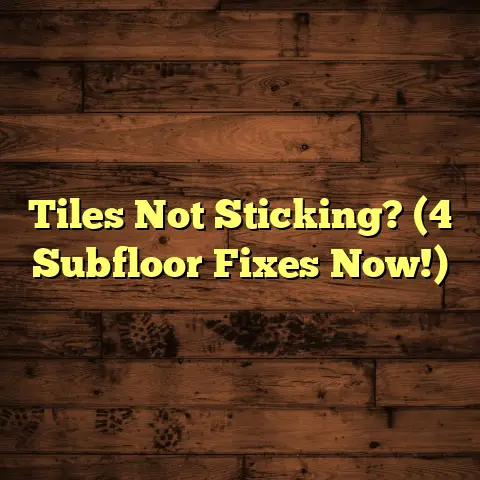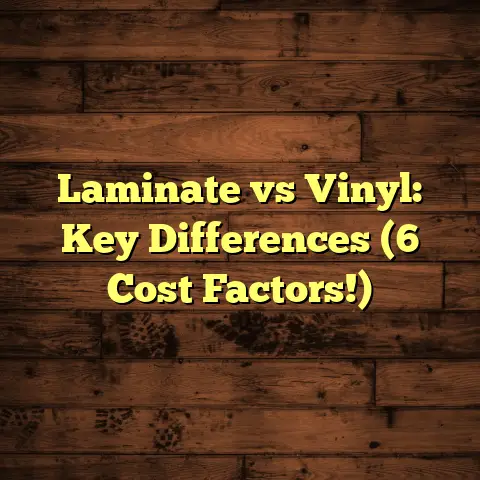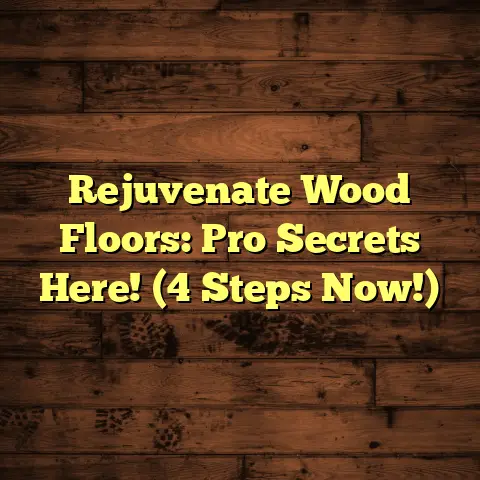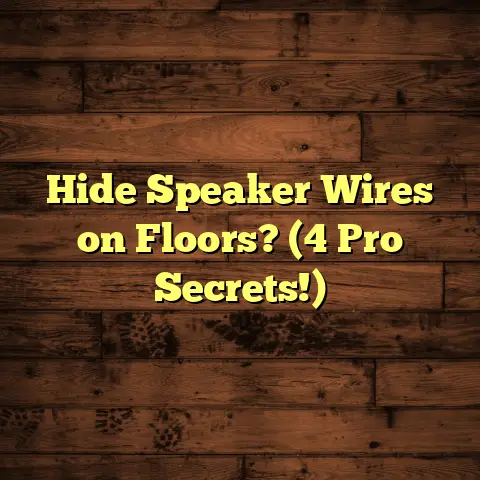Removing Glue Off Floor? (5 Pro Tips Here!)
Specifically, glue stuck stubbornly to your floor.
Removing old glue is a key investment.
It boosts your home’s value and look.
A clean floor makes your space look better.
Plus, it keeps your flooring in good shape.
Ever pulled up old carpet?
Or maybe removed some tiles?
Then you know the joy of finding a sticky mess.
It looks daunting, I know.
But with the right know-how, it’s totally doable.
I’m sharing pro tips to make it manageable.
Let’s turn frustration into satisfaction!
Section 1: Understanding Different Types of Glue
Okay, let’s talk glue.
Not all glues are created equal, trust me.
Knowing your enemy is half the battle.
Here’s a rundown of the usual suspects.
Vinyl Adhesive: This stuff is common under vinyl sheet flooring or tiles.
It tends to be water-based or acrylic.
It can soften with heat and moisture.
* Carpet Glue: This adhesive is designed to hold carpet in place, often a latex-based or pressure-sensitive adhesive.It can be a real pain to remove.
It leaves a thick, rubbery residue.
* Tile Adhesive (Thin-Set Mortar):This is a cement-based adhesive.
It’s used for ceramic, porcelain, and stone tiles.
It’s super strong and requires serious elbow grease.
* Wood Floor Adhesive:This is specifically for wood floors.
It’s usually a polyurethane or modified silane adhesive.
It’s designed to create a strong, flexible bond.
Each glue has different properties.
Some are water-soluble, others solvent-based.
Some get brittle with age, others stay gummy.
For example, I once worked on a job.
We were removing old vinyl flooring.
We thought we could just scrape it off.
Wrong! It turned out to be a super-strong adhesive.
We wasted hours before realizing we needed a solvent.
Understanding the glue dictates your approach.
Is it brittle? Is it gummy? Is it cement-based?
This knowledge determines your success.
It’s like choosing the right tool for a job.
Using a hammer on a screw won’t work, right?
Same goes for glue removal!
Section 2: Essential Tools and Materials for Glue Removal
Alright, let’s gear up.
Having the right tools makes all the difference.
It saves you time, energy, and headaches.
Here’s my go-to list:
Scrapers (Manual and Electric): A good scraper is your best friend.
Get a few different sizes and types.
A wide scraper for large areas.
A detail scraper for edges and corners.
Electric scrapers are amazing for big jobs.
They vibrate and make quick work of tough glue.
* Solvents (Acetone, Mineral Spirits, or Commercial Adhesive Removers):Solvents dissolve the glue.
Acetone works well on some adhesives.
Mineral spirits are a good all-around option.
Commercial removers are specifically formulated.
They’re often the most effective.
* Heat Guns or Steamers: Heat softens the glue.Making it easier to scrape off.
Heat guns are great for targeted heat.
Steamers are good for larger areas.
* Protective Gear (Gloves, Goggles, Masks): Safety first!Solvents can irritate your skin and eyes.
Wear gloves and goggles.
A mask protects you from fumes.
* Rags or Cloths: You’ll need these for applying solvents.Also for wiping up messes.
Keep plenty on hand.
* Floor Cleaners for Post-Removal: After removing the glue.You’ll need to clean the floor.
Use a cleaner appropriate for your flooring type.
Let’s talk safety.
Always work in a well-ventilated area.
Open windows and use a fan.
Solvents can be flammable.
Keep them away from heat and sparks.
Wear gloves and eye protection.
I can’t stress this enough!
I remember one time I skipped the gloves.
I was using a strong solvent.
My hands were burning for hours.
Learn from my mistakes!
Each tool has a specific purpose.
Scrapers lift the glue.
Solvents break it down.
Heat softens it.
Cleaners remove residue.
Using them in combination is key.
Section 3: Pro Tip #1: Test Before You Remove
This is HUGE.
Never, ever skip this step.
Testing can save you from disaster.
Before you go all-in, test a small area.
Choose an inconspicuous spot.
Like a corner or under a cabinet.
First, identify the glue and flooring.
What kind of glue is it?
What material is your floor made of?
This helps you choose the right solvent.
Now, apply a small amount of solvent.
Let it sit for the recommended time.
Then, try scraping the glue off.
Watch closely for any damage.
Does the solvent discolor the floor?
Does the scraper scratch the surface?
If you see any problems, stop immediately.
Try a different solvent or technique.
I once worked on a job where the homeowner.
He wanted to remove carpet glue from hardwood floors.
He skipped the test and used a strong solvent.
It stripped the finish right off the wood.
He ended up having to refinish the entire floor.
Testing prevents damage.
It helps you find the best approach.
It saves you time and money in the long run.
Think of it as a dress rehearsal.
You wouldn’t go on stage without practicing, right?
Same goes for glue removal.
Section 4: Pro Tip #2: Use the Right Solvent for the Job
Choosing the right solvent is critical.
It’s like choosing the right medicine.
You wouldn’t take cough syrup for a headache, right?
Here’s a breakdown of common solvents.
Acetone: Good for dissolving certain adhesives.
Like some vinyl glues.
It evaporates quickly.
Use in a well-ventilated area.
* Mineral Spirits: A versatile solvent.Works on many types of glue.
Less harsh than acetone.
But still requires ventilation.
* Commercial Adhesive Removers: Formulated specifically for glue removal.Often the most effective option.
But can be more expensive.
Always read the product label.
Understand the ingredients and safety precautions.
Safety Data Sheets (SDS) provide detailed information.
Including health hazards and first aid measures.
Apply the solvent liberally to the glue.
Let it dwell for the recommended time.
This allows the solvent to penetrate and break down the glue.
Agitate the solvent with a brush or scraper.
This helps it work its way into the glue.
After use, neutralize the solvent.
Wipe the area with a damp cloth.
Dispose of solvents properly.
Follow local regulations for hazardous waste disposal.
Never pour them down the drain.
I once used a solvent that was too strong.
It damaged the finish on a wood floor.
I learned my lesson the hard way.
Always test in an inconspicuous area first!
Section 5: Pro Tip #3: Heat is Your Friend
Heat can be a game-changer.
It softens the adhesive.
Making it easier to scrape off.
Think of it like melting butter.
It becomes soft and pliable.
The same principle applies to glue.
Heat guns and steamers are your allies.
Heat guns provide focused heat.
Great for small areas and stubborn spots.
Steamers provide moist heat.
Good for larger areas and delicate surfaces.
Safety is paramount when using heat.
Keep the heat gun moving.
Don’t hold it in one spot for too long.
You could scorch the flooring.
Wear gloves and eye protection.
The heat can be intense.
Start with a low setting.
Increase the heat gradually as needed.
Hold the heat gun or steamer a few inches away.
Apply heat for a few seconds at a time.
Then, try scraping the glue.
Repeat as needed.
I once used a steamer to remove carpet glue.
It was amazing!
The steam softened the glue.
I was able to scrape it off easily.
I saved hours of work.
Heat can make a huge difference.
But use it with caution.
Too much heat can damage the flooring.
Start slow and be patient.
Section 6: Pro Tip #4: Scraping Techniques
Scraping is an art.
It’s all about technique and finesse.
You want to remove the glue.
Without damaging the floor underneath.
There are many types of scrapers.
Each with its own advantages.
- Putty Knives: Good for small areas and detail work.
- Floor Scrapers: Wide blades for large areas.
- Razor Scrapers: For thin layers of adhesive.
- Oscillating Multi-Tools: With scraper attachments for versatile use.
Hold the scraper at a low angle.
This helps prevent gouging.
Apply steady, even pressure.
Don’t press too hard.
Let the scraper do the work.
Work in small sections.
Overlap each pass slightly.
This ensures you remove all the glue.
Keep the scraper blade sharp.
A dull blade is less effective.
It can also damage the floor.
Replace the blade as needed.
Avoid these common mistakes:
- Using too much pressure: This can damage the floor.
- Using the wrong angle: This can gouge the surface.
- Using a dull blade: This makes the job harder.
- Rushing the process: Take your time and be careful.
I once saw someone try to remove tile adhesive.
They used a hammer and chisel.
They completely destroyed the subfloor.
Don’t be that person!
Scraping takes time and patience.
But it’s worth it.
When you remove the glue without damage.
Section 7: Pro Tip #5: Clean Up and Restoration
You’ve removed the glue!
Congratulations!
But the job’s not done yet.
Cleaning up is essential.
You want to remove any residue.
And restore the floor to its original condition.
Start by sweeping or vacuuming.
Remove any loose debris.
Then, clean the floor with a suitable cleaner.
Use a cleaner appropriate for your flooring type.
Follow the manufacturer’s instructions.
Rinse the floor thoroughly with clean water.
Dry the floor with a clean cloth.
Inspect the floor for any damage.
Scratches, gouges, or discoloration.
If you find any damage, you may need to restore the floor.
This could involve:
- Refinishing: Sanding and applying a new finish to wood floors.
- Resealing: Applying a new sealant to tile or stone floors.
- Repairing: Filling in scratches or gouges with wood filler or epoxy.
Maintain the floor after restoration.
Clean it regularly with a suitable cleaner.
Avoid using harsh chemicals or abrasive cleaners.
Protect the floor from scratches and dents.
Use rugs or mats in high-traffic areas.
I once cleaned up a floor after glue removal.
I thought I had done a good job.
But a few days later, I noticed a sticky residue.
I had to go back and clean it again.
Don’t make the same mistake I did.
Be thorough with your cleanup.
Cleaning up and restoring the floor.
It’s the final step in the process.
It ensures that your floor looks its best.
Conclusion
Removing glue from floors is a challenge.
But it’s a manageable one.
With the right knowledge and tools.
You can achieve a clean, glue-free floor.
Remember these key points:
- Understand the type of glue.
- Use the right tools and materials.
- Test before you remove.
- Use the right solvent.
- Heat is your friend.
- Master scraping techniques.
- Clean up and restore the floor.
Don’t be intimidated by the task.
Approach it with confidence.
Armed with the pro tips I’ve shared.
The satisfaction of a clean floor is worth it.
It enhances the beauty of your space.
It creates a more pleasant environment.
So, go forth and conquer that glue!
You’ve got this!





